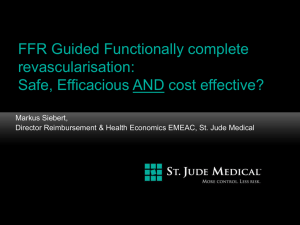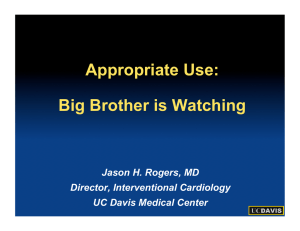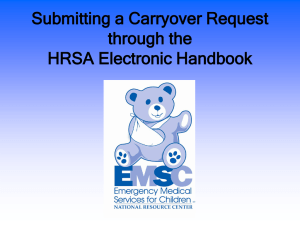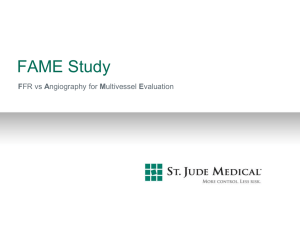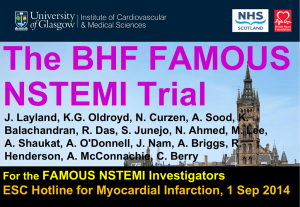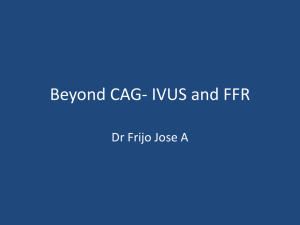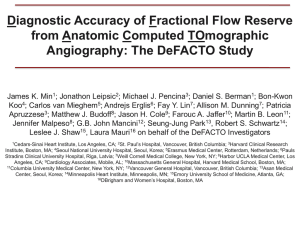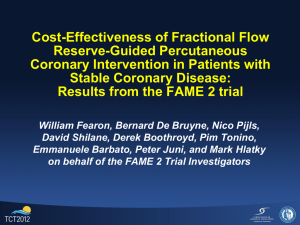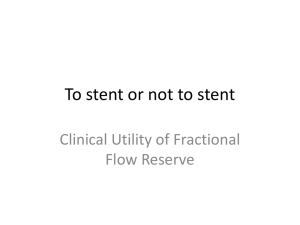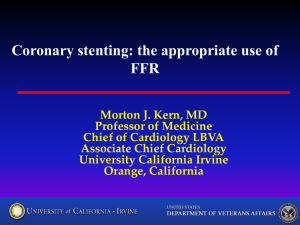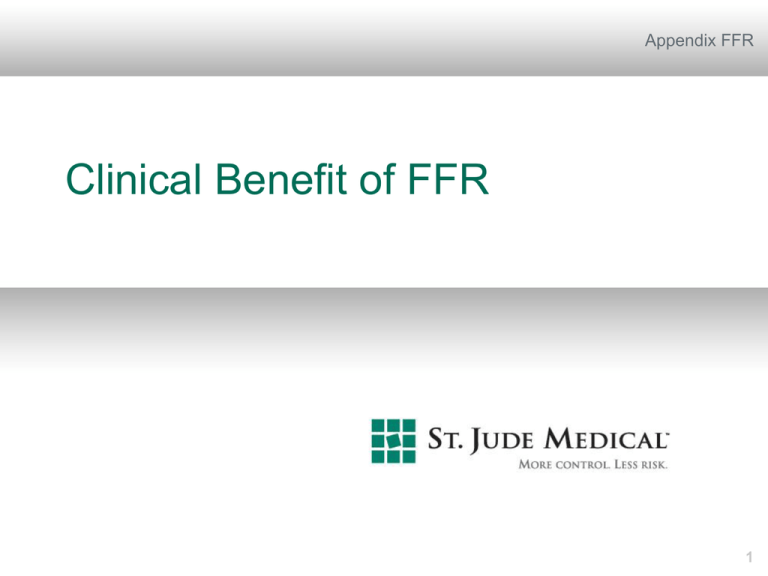
Appendix FFR
Clinical Benefit of FFR
1
Fractional Flow Reserve (FFR)
Definition of FFR:
“Maximum achievable blood flow in stenotic coronary
artery divided by maximum blood flow in the same artery
without stenosis”
2
FFR Measurement Correlates to the
Likelihood of Ischemia
Fractional Flow Reserve (FFR) is a
lesion-specific, physiological index
determining the hemodynamic severity of
intracoronary lesions.
FFR accurately identifies lesions
responsible for ischemia that in many
cases angiography or IVUS would not
have undetected or correctly assessed.
FFR measurement correlates to the
likelihood of ischemia with a validated
cut-off value of 0.75.
3
The FAME Study
The objective of the FAME
(FFR versus Angiography
for Multivessel Evaluation)
study was to determine if
routine measurement of
fractional flow reserve,
when combined with
angiography, improves
outcomes in patients
undergoing percutaneous
coronary intervention
(PCI).
4
FAME Study Design Chart
Patient with lesions ≥ 50% in at least 2
of the 3 major epicardial vessels
Indicate all lesions ≥ 50%
amenable for stenting
Randomization
FFR-guided PCI
Angiography-guided PCI
Measure FFR in all arteries
with ≥ 1 stenosis
Stent only those stenoses with
FFR ≤ 0.80
Stent all indicated stenoses
1, 2 and 5-year follow-up
5
Exclusion criteria:
LM disease, Previous CABG
MI < 5 days, unless cardiogenic shock
Pregnancy, Life expectancy < 2 years
FAME Study
Angiographic stenosis severity vs. FFR values
6
Tonino PA, Fearon WF, De Bruyne B, et al. Angiographic versus functional severity of coronary artery stenoses in the
FAME Study: Fractional flow reserve versus angiography in multivessel evaluation. J Am Coll Cardiol. 2010;55;25:2816.
The FAME Study Results¹’²
Compared to angiography-only procedures,
FAME one-year results show that FFR:
Reduces MACE at one year by 28%.
Reduces mortality and myocardial infarction at one year by 34%.
Is cost saving and does not prolong procedure time.
Decreases amount of contrast agent used.
Results in similar, if not better, functional status.
FAME two-year results show that FFR:
Reduces mortality and myocardial infarction (combined) by 34%.
Reduces myocardial infarction alone by 37%.
Is cost saving and improves procedure outcomes.
Saves on average $2,066 over one year.
1. Tonino PA, De Bruyne B, Pijls NH, et al. Fractional flow reserve versus angiography for
guiding percutaneous coronary intervention. N Engl J Med. 2009;360(3):213-24
2. TCT (Transcatheter Cardivascular Therapeutics) 2009, Late Breaking Clinical Trials
7
FAME:
Economics Sub-Analysis and
Comparisons Across Seven Countries
Cost-Effective vs. Cost-Saving
Cost-Effective:
A treatment option that results in benefits sufficiently large
compared to the costs, even if it does not save money.
What is considered cost-effective (i.e. good value for the
money) can differ from country to country.
Cost-Saving
A treatment option that decreases total costs and
improves outcomes.
9
2 (example Germany)
Cost
Effectiveness
Cost Effectiveness¹ (example Germany)
Increm. Cost (€)
2000
-0.075
-0.050
-0.025
FFR is clearly both costsaving and cost-effective
1500
1000
ICER of 50,000
€/QALY
500
0
-0.000
-500
0.025
0.050
0.075
Increm. QALY
-1000
-1500
-2000
1. Siebert U. Cost-Effectiveness and Public Health/Budget-Impact of FFR-Guided PCI in
Multivessel Patients in Europe—Analysis of the FAME Study Data. EuroPCR, 2011.
10
Results
Cost
Effectiveness Planes:
FFR
vs.vs.
Angio¹
Results
Cost-Effectiveness
Planes:
FFR
Angio
-0.075
2000
1500
1000
500
ICER of 50,000
€/QALY
0
-0.050 -0.025 -0.000 0.025 0.050 0.075
-500
Increm. QALY
-1000
-1500
‘Dominant’:
11
1500
1000
500
ICER of 43,700
€/QALY
(= 30,000
£/QALY)
2000
1500
1000
500
ICER of 50,000
€/QALY
0
0
-0.075
-0.050
-0.025
-0.000 0.025 0.050 0.075
-0.075 -0.050 -0.025 -0.000 0.025 0.050 0.075
-500
-500
Increm. QALY
Increm. QALY
-1000
-1000
-1500
52%
-2000
Cost effective:
Cost savings:
2000
Italy
Increm. Cost (€)
UK
Increm. Cost (€)
Increm. Cost (€)
France
90%
900 €/pat.
FFR is clearly both costsaving and cost-effective
-2000
-1500
63%
90%
600 £/pat.
-2000
65%
86%
300 €/pat.
1. Siebert U. Cost-Effectiveness and Public Health/Budget-Impact of
FFR-Guided PCI in Multivessel Patients in Europe—Analysis of the
FAME Study Data. EuroPCR, 2011.
BudgetImpact
ImpactAnalysis
Analysis
(example
Germany)
Budget
(example
Germany)¹
(€) 0 million
-25 million
-50 million
Best-case
Worst-case
Mean
-75 million
-100 million
-125 million
0
20
40
60
80
Degree of FFR penetration (%)
FFR is both cost-effective and
provides a positive budget impact
in major European markets
12
1. Siebert U. Cost-Effectiveness and Public Health/Budget-Impact of
FFR-Guided PCI in Multivessel Patients in Europe—Analysis of the
FAME Study Data. EuroPCR, 2011.
100
Conclusion
Average, FFR-guided PCI in patients with multivessel,
coronary artery disease and an intermediate stenosis is
cost saving and leads to better outcomes than
angiography-guided PCI¹
Depending on market uptake, introduction of FFR-guided
PCI could lead to:
Reduction in death, MI and other major adverse cardiac events
Improved quality of life of patients
Reductions in expenditure
Consistent results across Germany, France, UK and Italy²
May be generalized to other Western European countries
1. Tonino PA, De Bruyne B, Pijls NH, et al. Fractional flow reserve versus
angiography for guiding percutaneous coronary intervention. N Engl J Med.
2009;360(3):213-24
2. Siebert U. Cost-Effectiveness and Public Health/Budget-Impact of FFRGuided PCI in Multivessel Patients in Europe—Analysis of the FAME Study
Data. EuroPCR, 2011.
13
FAMECost-Effectiveness
Cost-Effectiveness
Analysis
FAME
Analysis
- Outcomes¹
Outcomes
1. Siebert U. Cost-Effectiveness and Public Health/Budget-Impact of FFRGuided PCI in Multivessel Patients in Europe—Analysis of the FAME Study
Data. EuroPCR, 2011.
14
New ESC Guidelines update September 2010
15
FFR Classification Upgraded to IA in the
ESC/EACTS Guidelines
16
1. Tonino PA, De Bruyne B, Pijls NH, et al. Fractional flow reserve versus angiography for guiding percutaneous coronary intervention. N Engl J
Med. 2009;360(3):213-24
FFR Strongly Recommended Before Deciding
on Treatment
The new guidelines support
measuring FFR before deciding to
perform PCI or send the patient to
surgery, in patients who come to
the cath lab without a prior
functional test and with a
stenosis(es) of 50-90% by
angiography,1 regardless of
whether the patient has singlevessel disease, multivessel
disease or if the vessel is
especially important (e.g.,
proximal LAD or LMCA).
17
1. Wijns W, Kolh P, Danchin N, et al. Guidelines on myocardial
revascularization: The task force on myocardial revascularization of
the European Society of Cardiology (ESC) and the European
Association for Cardio-Thoracic Surgery (EACTS). Eur Heart J.
2010;31(20):2501-55.
Supported by ACC/AHA/SCAI Guidelines¹ – 2009
The AHA/ACC/SCAI
guidelines are Class II
A, Level of Evidence
A, for determining
whether PCI of a
specific coronary
lesion is warranted.
1.
18
Kushner FG, Hand M, Smith SC Jr, King SB 3rd, et al; 2009
focused updates: ACC/AHA guidelines for the management of
patients with ST-elevation myocardial infarction (updating the
2004 guideline and 2007 focused update) and ACC/AHA/SCAI
guidelines on percutaneous coronary intervention (updating the
2005 guideline and 2007 focused update) a report of the
American College of Cardiology Foundation/American Heart
Association Task Force on Practice Guidelines. J Am Coll
Cardiol. 2009 Dec 1;54(23):2205-41.
Rx Only
Please review the Instructions for Use prior to using these devices for a
complete listing of indications, contraindications, warnings, precautions,
potential adverse events and directions for use.
Product referenced is approved for CE Mark.
ILUMIEN, Mobile Integration, Wi-Box, PressureWire, Aeris, RadiAnalyzer,
Dragonfly, C7-XR, Golden Image, the color gold, Radi, LightLab, ST.
JUDE MEDICAL, the nine-squares symbol and MORE CONTROL. LESS
RISK. are registered and unregistered trademarks and service marks of
St. Jude Medical, Inc. and its related companies. ©2011 St. Jude Medical,
Inc. All rights reserved.
IPN 1685-11

